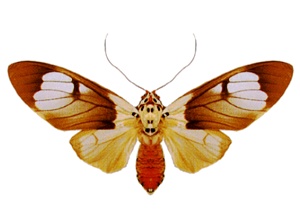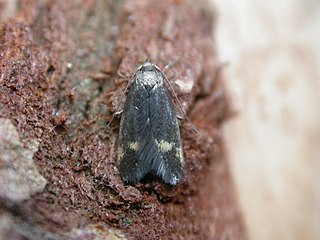
Copromorphidae, the "tropical fruitworm moths", is a family of insects in the lepidopteran order. These moths have broad, rounded forewings, and well-camouflaged scale patterns. Unlike Carposinidae the mouthparts include "labial palps" with the second rather than third segment the longest. With other unusual structural characteristics of the caterpillar and adult, it could represent the sister lineage of all other extant members of this superfamily. The genus Sisyroxena from Madagascar is also notable for its unusual venation and wing scale sockets.

Amerila is a genus of moths in the subfamily Arctiinae. A number of species in this genus have a special defence mechanism when they are in their adult stage. When disturbed, they exude a frothy yellow fluid from glands beside the eyes, while making a sizzling noise to ward off their attacker. Similar behaviour has been observed in fertilised females of the North-American moth Utetheisa ornatrix.

Macrobathra is a genus of moths in the family Cosmopterigidae. Most species are endemic to Australia.

Amerila crokeri, or Croker's frother, is a moth of the subfamily Arctiinae. The species was first described by William Sharp Macleay in 1826. It is found in the Australian states of New South Wales and Queensland and on New Guinea and New Britain.

Borkhausenia is not a genus of the concealer moth family (Oecophoridae) described by Jacob Hübner in 1825. Among these, it belongs to subfamily Oecophorinae, wherein it is probably closely related to Hofmannophila. In the past, several other Oecophoridae have been included in Borkhausenia, as well as a few even more distant members of the superfamily Gelechioidea. Metalampra was originally described as a subgenus of Borkhausenia. Telechrysis has also been included here as a subgenus by some, while other authors have considered it a separate genus in the Oecophorinae or – if these are also considered distinct – the Amphisbatinae.

The Autostichinae are a subfamily of moths in the superfamily Gelechioidea. Like their relatives therein, their exact relationships are not yet very well resolved. The present lineage was often included in the concealer moth family (Oecophoridae), but alternatively it is united with the Symmocidae sensu stricto to form an expanded family Autostichidae.

Autosticha is a genus of gelechioid moths. It belongs to the subfamily Autostichinae, which is either placed in the concealer moth family (Oecophoridae), or in an expanded Autostichidae. It is the type genus of its subfamily. Originally, this genus was named Automola, but this name properly refers to a fly genus in family Richardiidae.
Scieropepla is a genus of moths in the family Oecophoridae.
Megacraspedus serica is a moth of the family Gelechiidae. It was described by Edward Meyrick in 1909. It is found in South Africa.





